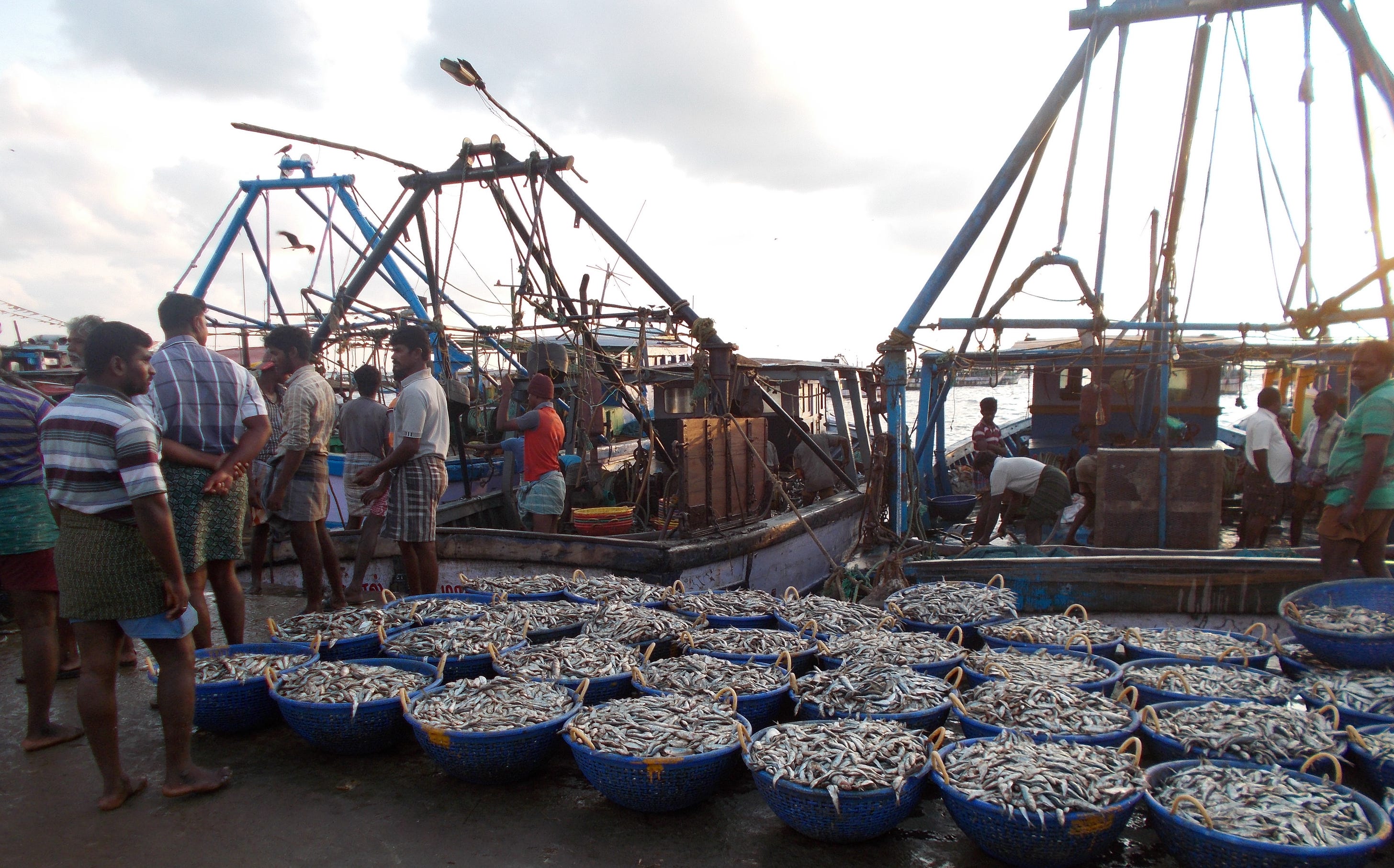|
 |
Industry Can Be a Powerful Ally in the Fight Against Global Overfishing
Fisheries management requires casting a wide net for a diversity of participants and science-backed perspectives
Some picture the fishing industry as a few large, wealthy fleets taking in government subsidies to overfish the world’s oceans—a depiction perhaps overly loved by environmental activists. In reality, the fishing industry is a world-spanning activity that encompasses fleet owners, seafood buyers, packagers and grocers, not to mention indigenous fishers and millions of people living in fishing communities. Efforts by members of the World Trade Organization (WTO) aim to curb overfishing by removing government subsidies that incentivize overfishing.
But some policy experts are urging a more nuanced approach. For example, Ernesto Fernández Monge is a senior officer at the Pew Charitable Trusts and supports WTO negotiators with his expertise on conservation and trade. He says top-down restrictions on subsidies, in addition to being difficult to achieve, may be necessary but not sufficient to address the global overfishing problem.
Clearly, government subsidies can have harmful effects on global fish stocks. Yet if subsidies to high-seas fishing fleets and even to local fishers were eliminated, fishing would become uneconomical in many regions. While few are advocating for policies that would end the economic viability of small- or large-scale fishers, the subsidies that lead to illegal, unreported and unregulated fishing remain the primary focus of the WTO’s ongoing efforts to curtail subsidies through international agreement. Most recently, the WTO Agreement on Fisheries Subsidies, adopted in 2022 but not yet fully operational, is designed to limit fishing subsidies.
But just as important, says Fernández Monge, is the role of industry in any solution. “Industry are the ones primarily affected. So, they should know that if they improve the conditions—the health of the oceans, the health of the stocks—they will get better yields.” If they don’t, the health of the oceans will continue to deteriorate, and yields will decrease, ultimately putting fishing operations out of business.
The fishing industry has a clear stake in the health of fisheries for future commercial viability. It also needs to respond to customer preferences. Policymakers are concerned about the livelihoods of workers and the economic well-being of the communities in which fisheries operate. An interdisciplinary approach to solving the overfishing problem seeks to align industry actors’ interests with those viewing the issue from environmental, conservation and biome perspectives. Rather than casting industry as a problem to be regulated, it might be more effective to enlist industry actors as partners in achieving sustainable yields and healthy fisheries.
Don’t Weaponize the Data
According to Matthew Fass, president of Maritime Products International, a global producer and distributor of seafood based in Newport News, Virginia, the first step is harmonizing the data used to regulate the fishing industry with the data used by the industry itself.
“What is the data really showing about the health of any given fishery?” Fass says. “What is in place to help ensure this information is being communicated to those who rely on a fishery for their business—hopefully with an eye toward cooperative efforts?”
Defining the health of a fishery is complicated enough without distrust about where the science comes from and how it is being used—if not manipulated—to suit the different agendas of interested parties. According to Fass, two-way, transparent communications that all stakeholders can understand is key to a successful fisheries management process.
Of course, such transparency is difficult in an industry that deals with circuitous supply chains and myriad actors with different and often conflicting interests. What seems right and proper for a regulator may be decried by fishers as onerous and arbitrary. For example, a case pending before the U.S. Supreme Court will determine whether the National Marine Fisheries Service may require fishing vessels to carry federal monitors on board at the owner’s expense. Regulators say the monitors are needed to enforce compliance with rules; fishers say the requirement is too expensive and will put them out of business.
Fass says regulators need to appreciate that industry will express skepticism with enforcement mechanisms, even if the skepticism is unfair. Some of that skepticism is a reaction to strong anti-fishing voices from environmental nonprofit organizations and activists. These groups often either ignore science completely or rely on dubious or opaque scientific claims, he says.
“Commercial fishing has always attracted a heavy dose of politics with critics coming from multiple angles,” Fass says. “This dynamic has escalated in recent years, making it that much more difficult to stay focused on stakeholder buy-in where it is badly needed.”
This is a common refrain in many industries that find themselves on the receiving end of activist calls for strict government regulation or even outright bans. Nuclear power generation comes to mind. In many cases, conflict arises over the quality and interpretation of scientific data and the motives of those who cite or challenge it.
Make Relevant Information Transparent
While the fishing industry has faced burdensome, politically motivated regulations, we must acknowledge that it has not always covered itself in glory with its efforts (or lack thereof) to preserve the health of fish stocks. The historic depletions of once-productive fisheries through overfishing, such as Georges Bank in the North Atlantic, show that fishers won’t always regulate themselves. The Food and Agriculture Organization of the United Nations reports that over 90% of the world’s fisheries are either fully exploited (57.3%) or overexploited (35.4%).
D.G. Webster, an associate professor of environmental studies at Dartmouth College, focuses on the power disconnects that prevent effective fisheries management and equitable distribution of maritime resources. She points out that seafood production throughout the world is dominated by a few transnational corporations. Rather than being on the receiving end of onerous regulations, she says, these entities wield significant economic and political power to both lobby rulemakers and insulate themselves from the economic consequences of overfishing.
In Webster’s view, this disparity in power between large-scale fishers and smaller operators and fishing communities results in a disconnect between those who profit most from fishing and those who are most affected by the depletion of fish stocks. Another important power disconnect occurs because consumers lack the information and leverage they need to “discipline producers through markets.”
“Supply chains are also long, convoluted, and difficult to trace,” Webster writes. “Even a wholesale giant like Costco has had trouble finding out where the shrimp it sells comes from, or whether it was processed by victims of human trafficking. So, some consumers are able and willing to pay more for sustainably harvested and ethically produced seafood but lack the information they need to make a well-informed choice.” To ensure that any government regulations of the fishing industry are effective and well-targeted, policymakers should consider the power disparities both within the industry itself and between industry actors and consumers.
Get Consumers Involved
Involving consumers in the fishery-to-table supply chain is key in developing market-based solutions to the problem of global overfishing. Erika Feller, regional director for the Americas at the Marine Stewardship Council (MSC), a nonprofit devoted to ending overfishing, says healthy and open collaboration between fishers and government managers is essential for effective fisheries management. One way to foster this collaboration is to encourage consumers to understand their role in ensuring sustainable fishing.
The MSC, for example, certifies the sustainability of a seafood producer’s product and communicates this to consumers through a “blue fish” logo that appears on the product’s label. “The MSC blue fish label provides market-based advantages, such as market access and price premiums,” Feller says. “As more MSC-labeled products become available, consumer awareness and retailer demand increase, which drives further interest in sustainability and thereby creates a virtuous loop. This is possible because of the two standards that MSC owns: the Fisheries Standard and the Chain of Custody Standard, which involves all steps in the supply chain.”
The MSC Fisheries Standard evaluates fisheries around the world on their ecological sustainability, environmental impact and compliance with existing laws and regulations. The Chain of Custody Standard provides assurance that seafood comes from a fishery certified as sustainable, and it requires producers to keep MSC-certified fish separate from uncertified fish all the way to store shelves.
Research shows that retailers participate in branding programs like MSC’s to improve their market share. However, how consumers respond to information implied in the labeling program is not completely understood. Furthermore, how such certification programs affect relationships in the industry—particularly between those inside and outside the programs—merits further study.
Sustain Fisheries Through Science and Markets
A brand, even if widely recognized by consumers, is only as authoritative as the science behind it. Feller says the MSC undertakes a formal review of the Fisheries Standard every five years to make sure its assessment and certification system remains the leading international standard for sustainable fishing.
“The latest version of the MSC Fisheries Standard was launched last year, following the most extensive review of marine science and fisheries best practices we’ve ever undertaken,” she says, adding that the new standard is the culmination of more than four years of research, public consultation and testing during which the MSC reviewed more than 600 submissions from stakeholders with expertise in fishing, ocean conservation, certification and seafood.
“In addition, the MSC Fisheries Standard requires rigorous, peer-reviewed science and information for any assessments that occur. MSC recently introduced an evidence-based framework which ensures the truth and accuracy of any information included in an assessment. Like the U.S. management process, the MSC process is transparent with multiple opportunities for stakeholders to input.”
Programs like the MSC’s blue fish label offer an opportunity for consumers to “discipline” their seafood providers, as Dartmouth’s Webster phrased it. Because branding programs—unlike government-mandated labeling—are voluntary, consumers are the ultimate arbiters of whether a product is welcome in their homes. If consumers lack the ability to assure the sustainability of a given fishery, a science-based and rigorously audited branding program can at least communicate to them that the harvest they enjoy meets a certain sustainability standard.
“Together, the fishing industry and government can work collaboratively with a wide range of interested stakeholders and scientists to understand what’s happening on the water,” Feller says. “It’s so important to get different parties and stakeholders together to share and understand fisheries data. For example, in the U.S. there are eight regional fishery management councils, which are collaborative management bodies that develop management plans designed to address the long-term health of U.S. fisheries. Having open stakeholder meetings is part of their remit.”
Fass agrees that science can enable regulators and industry to collaborate on policies that will be more effective at managing fisheries. “The most important thing a managing agency can do is to create ongoing procedures of assessment focused on the science that are as clean and free from politics as possible,” he says, “and be clear on how the assessments are made.”
The Mercatus Center and the Center for Governance and Markets at the University of Pittsburgh have partnered on their Future Fisheries Management project to pioneer an interdisciplinary approach to the overfishing problem. The aim is to contribute to effective implementation of the WTO agreement, including informing WTO members in their next ministerial conference, scheduled to take place in Abu Dhabi in February 2024. Widespread adoption of this interdisciplinary approach will benefit all stakeholders, including industry actors, environmental activists and consumers.
The real challenge for WTO members will come after the agreement is signed—that is, in the implementation phase. Policymakers must leverage industry expertise to design implementation that encourages sustainable fisheries across the entire supply chain, from catch to table.
You’re currently a free subscriber to Discourse .


